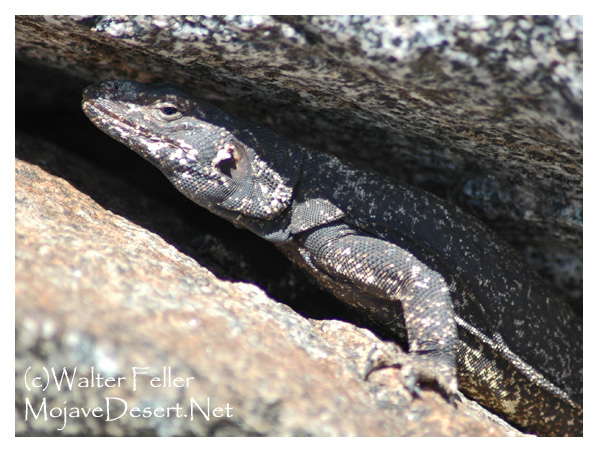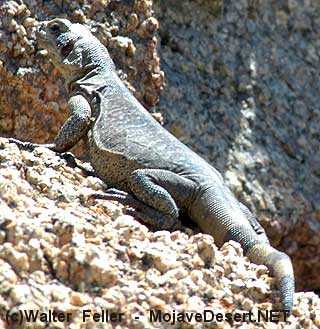Chuckwalla
Sauromalus aterFamily: Iguanidae Order: Squamata Class: Reptilia

Natural History of the Chuckwalla
Description
The chuckwalla (genus Sauromalus) is a large lizard native to arid regions of the southwestern United States and northern Mexico. These reptiles are characterized by their robust bodies, loose folds of skin around the neck and sides, and a broad, flat tail. They can grow up to 16 inches (40 cm) in length.Habitat
Chuckwallas thrive in rocky, desert environments, particularly in areas with abundant crevices and rock piles where they can hide. These habitats provide the necessary shelter from predators and extreme temperatures. They are often found in lava flows, rocky hillsides, and outcrops within desert scrub and creosote bush communities.Behavior
Chuckwallas are primarily diurnal, meaning they are active during the day. They are known for their unique defense mechanism of wedging themselves tightly into rock crevices when threatened, inflating their bodies to make it difficult for predators to extract them.Diet
These lizards are herbivorous, feeding mainly on leaves, flowers, and fruits of desert plants. Their diet includes various species of desert flora such as creosote bush, desert marigold, and various cacti. They have a strong preference for yellow flowers, which are more visible in their environment.Reproduction
Chuckwallas typically mate in the spring, with females laying eggs in early summer. A female can lay between 5 to 16 eggs in a clutch, which she deposits in a shallow burrow or under rocks. The eggs incubate for about two to three months before hatching.Adaptations
Thermoregulation:
Chuckwallas are ectothermic and rely on external heat sources to regulate their body temperature. They bask in the sun during the cooler parts of the day and seek shade during the hottest periods.Water Conservation:
As desert dwellers, chuckwallas have adapted to conserve water. They obtain most of their hydration from the moisture content in their food and can survive for long periods without drinking water.Coloration:
Their coloration ranges from a dull grey or brown to more vibrant yellows and oranges, providing excellent camouflage against the rocky terrain of their habitat.Conservation
While chuckwallas are not currently considered endangered, habitat destruction and human activities pose potential threats to their populations. Conservation efforts focus on preserving their natural habitats and minimizing the impact of development and recreational activities in desert regions.Interesting Facts
Chuckwallas are often seen performing push-ups, a behavior used to communicate and assert dominance among males. They have a strong social structure, with dominant males defending territories that include basking sites and food resources. These lizards are an important part of the desert ecosystem, helping to control plant growth and providing a food source for predators. The chuckwalla is a fascinating example of adaptation and survival in one of the harshest environments on Earth, showcasing the resilience and diversity of desert wildlife.desert woodland, scrub habitats, creosote communities, herbivore, wildflowers, creosote, perennials and annuals, coyotes, snakes.
The chuckwalla is a consumer in the desert food chain
The chuckwalla is potential prey for: Red-tailed Hawk, American Kestrel, Coyote, Mojave Rattlesnake.

Common Chuckwalla
"Often we see them waddling along, then suddenly leaping from rock to rock. in spite of their ungainly appearance, they move about with great speed -- in contrast to their profound patience while lying still. One that I found eating flowers in an encelia bush suddenly dropped down and took refuge in a rock crevice. It was more than an hour before it came forth and began feeding again."
Edmund C. Jaeger
-- Desert Wildlife





